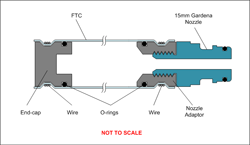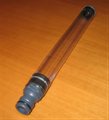Aim
- To test the failure pressure of regular T8 FTC.
- To test the failure pressure of glass strapping tape reinforced
T8 FTC.
Experiment Setup
The standard hydrostatic burst test procedure was used to carry
out these tests. (See above)
The FTC used for these tests only has an
average wall thickness of 0.36mm. We made an end-cap out of some
PVC we had on hand and the nozzle is
based on a 15 mm Gardena nozzle. The one we
bought from the local hardware store came
with an outside thread. We machined an
adaptor with a matching thread that fits
snugly inside the FTC. We then epoxied the
nozzle inside the adaptor. The seal for the
end-cap and nozzle is provided by an o-ring
that sits against the FTC. Just behind the
o-ring is a groove that allows us to shrink
the FTC into it to hold the end-cap and
nozzle in place. We copied this technique
from
Urie's water rockets.

To secure the end-cap and nozzle we wrapped a
couple of loops of thin fencing wire around
the FTC just over the groove. We then apply
heat from a heat gun to the FTC while
applying tensile stress to the wire. This
allows the wire to deform the FTC into the
groove. We then let it cool down and twist
the wire closed. For the first test we used
a 1 foot length of the FTC and secured the
end-cap and nozzle at either end.
Results
Test #1
 |
FTC just after the 190psi burst test. |
 |
Detail showing where the wire sits in the
groove at the nozzle end. |
 |
Burst location. |
We hydrostatically tested the FTC to
190 psi before the FTC split. The end-cap and nozzle held and
that there were no leaks.
Test #2
We hydrostatically tested a 1
foot length of FTC wrapped with one layer of fiber
glass strapping tape. We also added a number
of extra wraps of the tape around each end
right near the o-rings to help with the
seal.
 |
FTC test with glass fiber strapping tape
reinforcement. |
 |
At 230psi the end cap came out. The flare at
the end of the FTC was due to the heating
process and normally would be removed for a real
rocket. |
As we reached
230 psi the end-cap flew out of the FTC. It
looks like the groove in the end-cap was not
deep enough and the wire probably loosened
where it was twisted. This allowed the
end-cap to slide past the wire.
There was no
damage done. The single layer of tape added 7grams to the
1 foot length of FTC. |